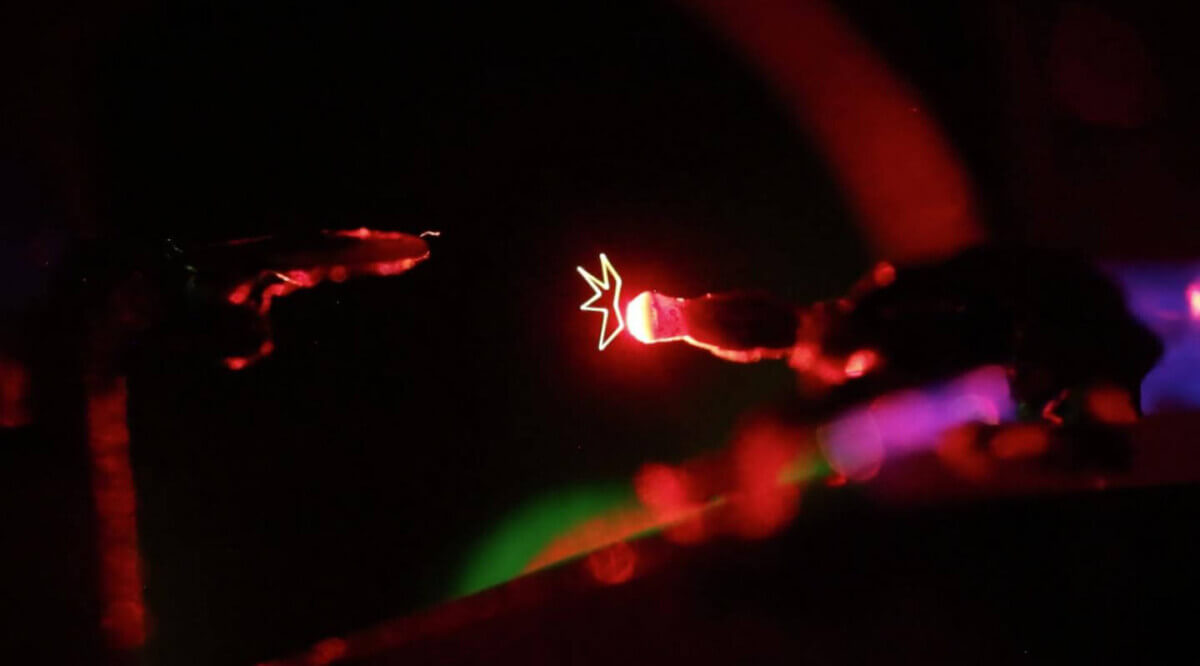
A tiny Starship Enterprise fires on a tiny Klingon Battle cruiser with real animated images created in thin air. (Credit: BYU)
PROVO, Utah — Every young “Star Wars” fan has their favorite lightsaber color. Red for Darth Vader? Maybe green, just like Yoda's and Luke Skywalker's? Although such discussions usually take place during fan conventions, researchers in Utah have figured out how to make these saber duels a reality — sort of. In the next step in hologram technology, a team has created “natural” lightsabers, complete with “luminous beams.”
Moving on to another famous sci-fi franchise, researchers from Brigham Young University demonstrated how they could engineer “real” laser battles between tiny versions of “Star Trek's” U.S.S. Enterprise and a Klingon ship. This little scene even involves “photon torpedoes” that viewers can clearly see flying between the vessels through mid-air.
“What you're seeing in the scenes we create is real; there is nothing computer generated about them,” explains lead researcher Dan Smalley, a professor of electrical engineering, in a university release. “This is not like the movies, where the lightsabers or the photon torpedoes never really existed in physical space. These are real, and if you look at them from any angle, you will see them existing in that space.”
Making a ‘3D printer for light'
This study is the next chapter in Smalley's work that garnered serious national attention three years ago. At that time, his team discovered how to draw screen-less, free-floating objects in space. These objects, which researchers call “optical trap displays,” are created when a single particle in the air is trapped with a laser beam and then moved around. This leaves behind a laser-illuminated path that floats in mid-air, similar to “a 3D printer for light.”
Their next project involved producing simple animations in thin air. These new advancements open the door toward the development of holographic-like virtual objects capable of “co-existing” in one's immediate space.
“Most 3D displays require you to look at a screen, but our technology allows us to create images floating in space — and they're physical; not some mirage,” Smalley says. “This technology can make it possible to create vibrant animated content that orbits around or crawls on or explodes out of every day physical objects.”
By creating virtual stick figures that walk on air, researchers could illustrate interactions between their virtual images and real-life humans. Researchers accomplished this by having a student put a finger in the middle of the volumetric display. They then observed the same stick finger walking along and jumping off that finger.
Scientists overcome major hurdles in virtual imaging with holograms
This study is also notable for yet another reason. It has overcome a big issue with this topic in the past: the tech being unable to show virtual images. This work confirms that scientists can simulate virtual images by employing a time-varying perspective projection backdrop.
“We can play some fancy tricks with motion parallax and we can make the display look a lot bigger than it physically is,” study co-author Wesley Rogers concludes. “This methodology would allow us to create the illusion of a much deeper display up to theoretically an infinite size display.”
The study appears in the journal Scientific Reports.










